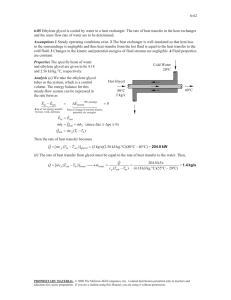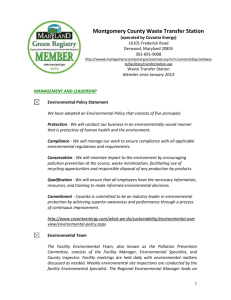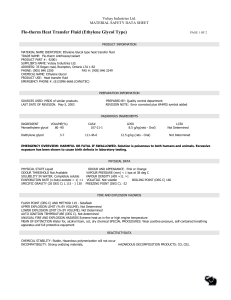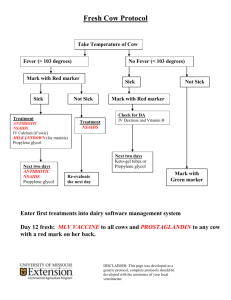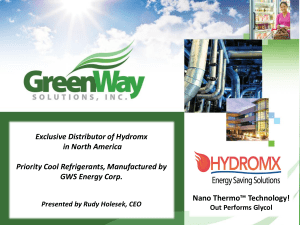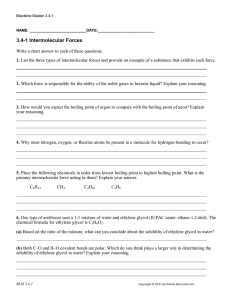Dispelling the Myths of Heat Transfer Fluids
advertisement
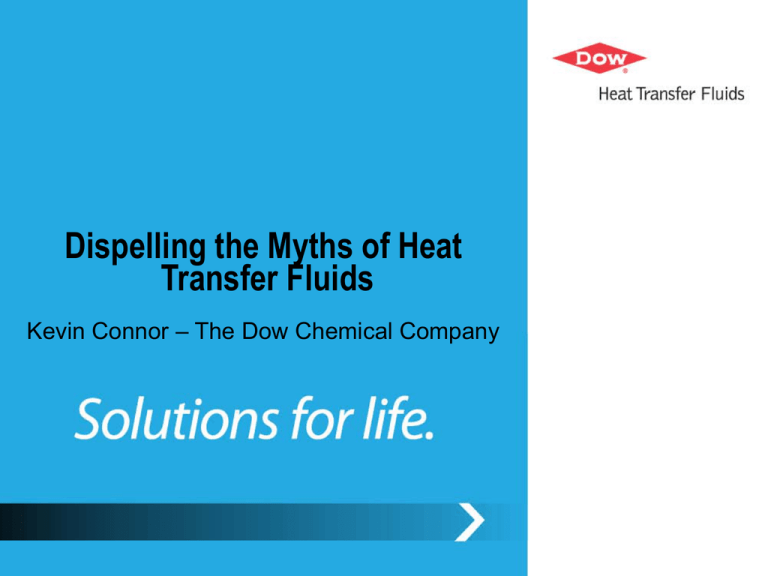
Dispelling the Myths of Heat Transfer Fluids Kevin Connor – The Dow Chemical Company Heat Transfer – Chill Water Loop Secondary Coolant (Heat Transfer Fluid) Primary Refrigerant Expansion Device Air Handler Evaporator Pump 2 Compressor Condenser The Need for “Antifreeze” • Water is almost a perfect fluid… – Excellent heat transfer – Excellent health & safety – Low cost • BUT water freezes at 0oC / 32oF • Antifreeze protects system piping and components from damage caused by freezing – Volume expansion due to ice crystals generates pressure which ruptures pipes and can destroy equipment Heat Transfer Fluid “Wish List” • Effective freeze protection – Freezing point below -40oC / -40oF • Efficient heat transfer over broad temperature range – -15oC to 125oC / 0oF to 250oF • No harmful effects (health, safety, environment) – Non-toxic, non-flammable, environmentally benign • Non-corrosive / non-destructive to materials – 20+ year fluid life • Low cost – Low power consumption, low capital cost, and low maintenance 4 Choice of Heat Transfer Fluids • Salt based (brines) – – – – – – – – Lithium bromide Calcium chloride Magnesium chloride Sodium chloride Potassium acetate Potassium formate Potassium carbonate Betaine • Alcohols & Glycols ̶ ̶ Methanol Ethanol Ethylene glycol Propylene glycol 1,3-propanediol Glycerin ̶ ̶ ̶ ̶ • Non-aqueous Fluids ̶ ̶ 5 Mineral oils Synthetics Impact on Freezing Point Data from Melinder 2007 “Thermophysical Properties of Aqueous Solutions Used as Secondary Working Fluids “ 6 Impact on Corrosion 15% Methanol 7 15% Propylene Glycol Water Corrosion • All salts are very corrosive – Long term protection is impossible even with corrosion inhibitors • Glycols or alcohols (without corrosion inhibitors) are corrosive to most metals – Oxidize to form acids low pH acidic pH is corrosive – Must use correct type of corrosion inhibitor technology • Corrosion damage can occur in less than 2 years – Worse for high temperatures and high exposure to air or dissolved O2 8 Corrosion Control • Corrosion can be limited by control of key environmental variables ̶ Design & Operation ̶ Materials ̶ Temperature & exposure to O2 ̶ Fluid Chemistry ̶ Corrosion inhibitors & pH ̶ Fluid purity • Maintain metal in passive rather than active state – Corrosion rate 1000 times lower Impact on System Efficiency Physical Properties @ 10oC/ 50oF * Data from Melinder 2007 “Thermophysical Properties of Aqueous Solutions Used as Secondary Working Fluids “ Fluid Description Freezing Point ( oC ) Thermal Conductivity (W / m.K) Volumetric Heat Capacity (kJ / L.K) Viscosity (cP) water 0 0.582 4.18 1.3 Methanol * 12 wt% - 7.5 0.525 3.86 1.3 Ethanol * 15 wt% - 7.5 0.500 3.83 2.7 Ethylene Glycol * 19 wt% -7.5 0.501 3.94 2.0 Propylene Glycol * 20wt% -7.5 0.484 3.86 2.8 Glycerol * 26wt% -7.5 0.481 3.97 3.1 ~0.16 ~1.6 ~28 Mineral Oil (VG2) -15 (pour pt.) System Performance • Adding antifreeze to water negatively impacts system performance – Must trade performance for freeze protection • Reduced heat transfer efficiency ̶ ̶ Antifreeze decreases thermal conductivity & specific heat How much will system performance be reduced? ̶ Regrettably there is no “one size fits all” answer • Increased power consumption – Antifreeze increases viscosity affects pump horsepower and fluid flow 11 Impact on Health & Safety • Methanol and ethylene glycol are classified as moderately toxic – About 125 mLs is lethal dose for typical sized adult • Industrial ethanol (not for consumption) is denatured – Can contain methanol, pyridine or other (toxic) denaturants • Only propylene glycol is formally approved by FDA – Direct food additive – essentially non-toxic – Generally Regarded As Safe (GRAS) • Alcohols are low boiling fluids with low flash points – Flammability and fire safety concerns 12 Fire Safety RCRA hazardous Flash point temperature [deg F] waste (ignitable) OSHA hazardous material (flammable) 122 115 109 103 99 96 93 91 89 84 86 LFL “pure” ethanol = 4% Flash pt = 13oC / 55oF Trademark of The Dow Chemical Company 13 Advantages of Using Glycol Effective Freeze Protection Non-corrosive (if properly formulated) Relatively Efficient Heat Transfer No Adverse HS&E Effects Heath – Low toxicity (PG fluids) Safety – Non-flammable Environment – Readily Biodegradable Relatively Low Cost 14 Advantages of Choosing Dow • Dow heat transfer fluids are properly formulated with corrosion inhibitors and pH buffers which ̶ ̶ Passivate metal surfaces prevent corrosion Neutralize degradation compounds prevent pH drop Thermoxidatively stable provide long term protection ̶ • Avoid cooling tower inhibitor packages – Designed for water --- not glycol • Avoid automotive coolant inhibitors – Designed for relatively short fluid lifetimes 15 DOWTHERM™ SR-1 Fluid • Ethylene glycol-based fluid (95%) • Fluorescent pink • Efficient heat transfer – -28° to 120° C • Provides freeze / burst protection – • -51° C / -60° C (depending on concentration) Dow is the oldest back-integrated supplier of glycol based heat transfer fluids: – DOWTHERM™ SR-1 originated in the late 1940’s DOWFROST™ Fluid • Propylene glycol-based fluid (96%) • Water white • Low toxicity – fully complies with FDA & NSF regulations – Made with DOW PuraGuard™ Propylene Glycol USP/EP • Efficient heat transfer – -18° to 120° C • Provides freeze / burst protection – -51° C / -60° C (depending on concentration) Advantages of DOW PuraGuardTM • DOWFROST™ is the only inhibited glycol made with DOW PuraGuard™ Propylene Glycol USP/EP, a pharmaceutical grade of monopropylene glycol with a specified purity of 99.8% or greater • Competitive products are made with lower quality PG ̶ Fluid lifetime & safety are compromised • Industrial grade PG or bio-derived PG can have: ̶ ̶ 18 High aldehydes & dioxolanes odor forming compounds High ethylene glycol & diethylene glycol toxic compounds DOWFROST™ HD Fluid • Propylene glycol-based fluid (94%) • Fluorescent yellow • Fortified inhibitor package versus regular DOWFROST™ – Does not have same FDA / NSF approval • Efficient heat transfer – -18° to 135° C • Provides freeze / burst protection – • -51° C / -60° C (depending on concentration) Available as concentrate or premixed solution – Customer blends available from Dow distributors DOWFROST™ GEO 20 • Propylene glycol-based fluid (20 vol%) – Fluorescent yellow • Designed for Geothermal Heat Pumps – Lower concentration means lower pumping cost & higher heat transfer efficiency – Excellent corrosion protection – Bio-static concentration (will not support bio-degradation / biofouling unless diluted) • Operating range: – • 23° to 212° F with 18.5° F freeze point Drum & smaller packages available from Dow distributors Which Product Do I Choose? • Ethylene glycol (EG) is moderately toxic – ~½ cup is lethal to an average size adult • Propylene glycol (PG) is essentially non-toxic – Approved by FDA as direct food additive • Use DOWFROST™ for low toxicity needs – Food processing (DOWFROST™ only) – Schools or hospitals (DOWFROST™HD) • Use DOWTHERM™SR-1 for other applications – EG provides better performance (heat transfer & pumping power) lower cost option 21 Avoid Poorly Formulated Products Metal Test Data ASTM Limit Copper 1.6 10 Solder 9.2 30 Brass 3.7 10 Steel 199 10 Cast Iron 297 10 Aluminum 88 30 Tips for Proper Operation • Use purified water (distilled, de-ionized) for dilution • Install and maintain “correct” glycol concentration – Over-dilution causes corrosion & bio-fouling – Too concentrated causes poor heat transfer • Operate within recommended temperature ranges – Over-heating compromises fluid life • Test your fluid regularly – Good fluid maintenance helps prolong the life of your system 23 Water Quality • • • Salts cause corrosion Hardness causes scales & sludge Requirements for dilution water ̶ ̶ ̶ Chlorides <25 ppm Sulfates <25 ppm Total hardness (as CaCO3) <100 ppm Over-Dilution • Over-dilution causes corrosion and biofouling ̶ ̶ Glycol degradation Unpleasant odors • Minimum concentration ̶ • 20% - 25% Maximum concentration ̶ 25 60% - 65% Bio-fouling - customer sample with 11% propylene glycol Over-Heating • Fluid degradation and corrosion increase as temperature increase ̶ • Fluid life compromised Temperature limits ̶ ̶ Max bulk: 250 F to 350 F Max film: 300 F to 400 F Increased time / temperature, exposure to 02 / air Dow Analytical Service • Free service if system contains more than 250 gallons of DOWTHERM™ SR-1 / DOWFROST™ • Sample analysis kits are available from Dow – “2 PAK’s” and “6 PAK’s” • Send samples to Dow laboratory and receive comprehensive analysis & report within 2 weeks • Detailed analysis: – Glycol concentration & freeze point – Corrosion inhibitors, pH, various contaminants – System maintenance recommendations 27 Sample Kits Example Report 29 The Bottom Line • • Glycol based fluids provide excellent overall protection Understand the impact that glycol has on water • • Select and use a properly formulated glycol based fluid • • Trade off between performance versus freeze protection Specifically designed for HVAC applications Correctly installed and maintained DOWTHERM™ and DOWFROST™ inhibited glycol heat transfer fluids can help protect your system for 20+ years www.dowfrost.com
